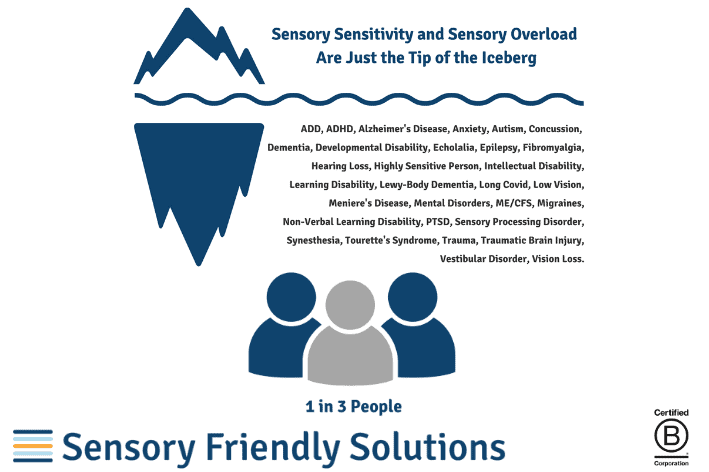Table of Contents
Creating Safer, Calmer Spaces
Introduction: Why Sensory-Friendly Environments Matter in Trauma-Informed Care
When someone experiences trauma, their brain and body react to everyday environments in unexpected ways. For example, noises feel louder, lights feel brighter, and crowds feel overwhelming. So, that’s why being sensory-friendly and trauma-informed go hand in hand.
Creating trauma-informed spaces means understanding how people react to the world around them. Moreover, being sensory-friendly helps reduce stress and anxiety, especially for people with trauma histories.
And it’s not just about therapy spaces. In fact, schools, workplaces, public events, and even stores can—and should—be trauma-informed and sensory-friendly.
What Does It Mean to Be Sensory-Friendly?
Sensory-friendly means adjusting a space to reduce sensory overload. For instance, that includes things like:
- Dimming bright lights
- Reducing loud or sudden sounds
- Offering quieter times or sensory rooms
- Allowing flexible seating or movement
- Using neutral colors or calming décor
In addition, these changes support people with autism, ADHD, anxiety, PTSD, or sensory processing challenges. But really, they make spaces better for everyone. Furthermore, you can learn more in our blog: What Is a Sensory-Friendly Environment?

Understanding Trauma and Trauma-Informed Care
Trauma is a response to deeply distressing events. Importantly, it can change how someone thinks, feels, and reacts—especially to sensory input.
Trauma-informed care is an approach that:
- Recognizes the widespread impact of trauma
- Acknowledges signs and symptoms of trauma
- Responds with supportive practices
- Avoids re-traumatizing people
Sensory overload can trigger trauma responses. As a result, that’s why trauma-informed care needs to include sensory-friendly strategies.
Why Trauma-Informed and Sensory-Friendly Go Together
Being trauma-informed isn’t only about emotional safety—it’s also about physical and sensory safety. For example:
- A trauma survivor may panic in a noisy, crowded room.
- Someone with PTSD may react to flashing lights or sudden movements.
- Bright lights can be overwhelming after a panic attack.
Thus, sensory-friendly practices reduce these stressors, helping people feel safer and more in control.
A Real-World Example: Calming the Chaos
Imagine visiting a community center. The overhead lights buzz, the music is loud, chairs are close together, and announcements blare over a speaker.
Now, on the other hand, imagine the same center with:
- Soft lighting
- No background music
- Clear signs and a quiet room nearby
- Friendly staff trained in sensory and trauma-aware practices
So, which space would feel safer, calmer, more welcoming?
That’s the power of combining sensory-friendly design with trauma-informed care.
How to Create Sensory-Friendly, Trauma-Informed Spaces
First, start with simple, low-cost steps:
1. Light and Sound
- Use dimmable or natural lighting
- Avoid sudden loud sounds
- Provide noise-canceling headphones or earplugs
2. Visual and Physical Clutter
- Keep spaces clean and uncluttered
- Use calm, muted colors
- Offer clear signs and labels
3. Offer Choice and Control
- Let people choose where to sit or stand
- Allow breaks or time-outs
- Make exits easy to find
4. Train Staff
- Provide training on sensory awareness and trauma-informed care
- Teach respectful communication and nonjudgmental listening
5. Include Everyone
- Ask for feedback from people with lived experience
- Test solutions with real users
- Finally, make changes based on what they tell you

FAQs About Sensory-Friendly and Trauma-Informed Care
What’s the difference between sensory-friendly and trauma-informed?
Sensory-friendly focuses on reducing sensory overload. Trauma-informed adds emotional safety and support for those with trauma histories. Importantly, they work best together.
Who benefits from sensory-friendly environments?
Everyone! But especially people with PTSD, autism, ADHD, anxiety, brain injuries, or sensory sensitivities. Read our blog: Who Has Sensory Sensitivity? In fact, sensory sensitivity and sensory overload are just the tip of the iceberg.

Can sensory-friendly changes be made on a low budget?
Yes. Small changes like turning down lights or reducing noise are free or low-cost. In fact, many solutions are simple and low-tech.
Why should businesses care about being trauma-informed?
It improves customer experience, staff wellbeing, and inclusivity. Moreover, it’s also the right thing to do.
How do I start making my space more sensory-friendly?
Start small: reduce clutter, lower noise, and train staff. Then grow your knowledge through training and expert advice.
Showcase Sensory Friendly Solutions
All Access Training Membership
At Sensory Friendly Solutions, we make it easy to learn how to become trauma-informed and sensory-friendly. With our All Access Training Membership, you get:
- Sensory Friendly 101
- Industry-specific courses tailored to your needs
- Over 20 downloadable guides, checklists, and resources
- Flexible, self-paced online learning
- Access to our exclusive learning community
In fact, whether you’re a teacher, business owner, event planner, or health care provider, our training supports your journey to more welcoming, inclusive spaces.
Explore More Resources
- Check out our posts on Sensory Rooms
- Learn how to create Sensory-Friendly Workplaces.
- Discover calming Classroom Sensory Activities.
Newsletter Sign-Up
Want more tips like these? Sign up for our newsletter!
You’ll get:
- Exclusive sensory-friendly insights
- Training updates and resources
- Inspiring stories and case studies
- First access to new courses and offers
👉 Finally, don’t forget to check your junk folder and confirm your subscription!








